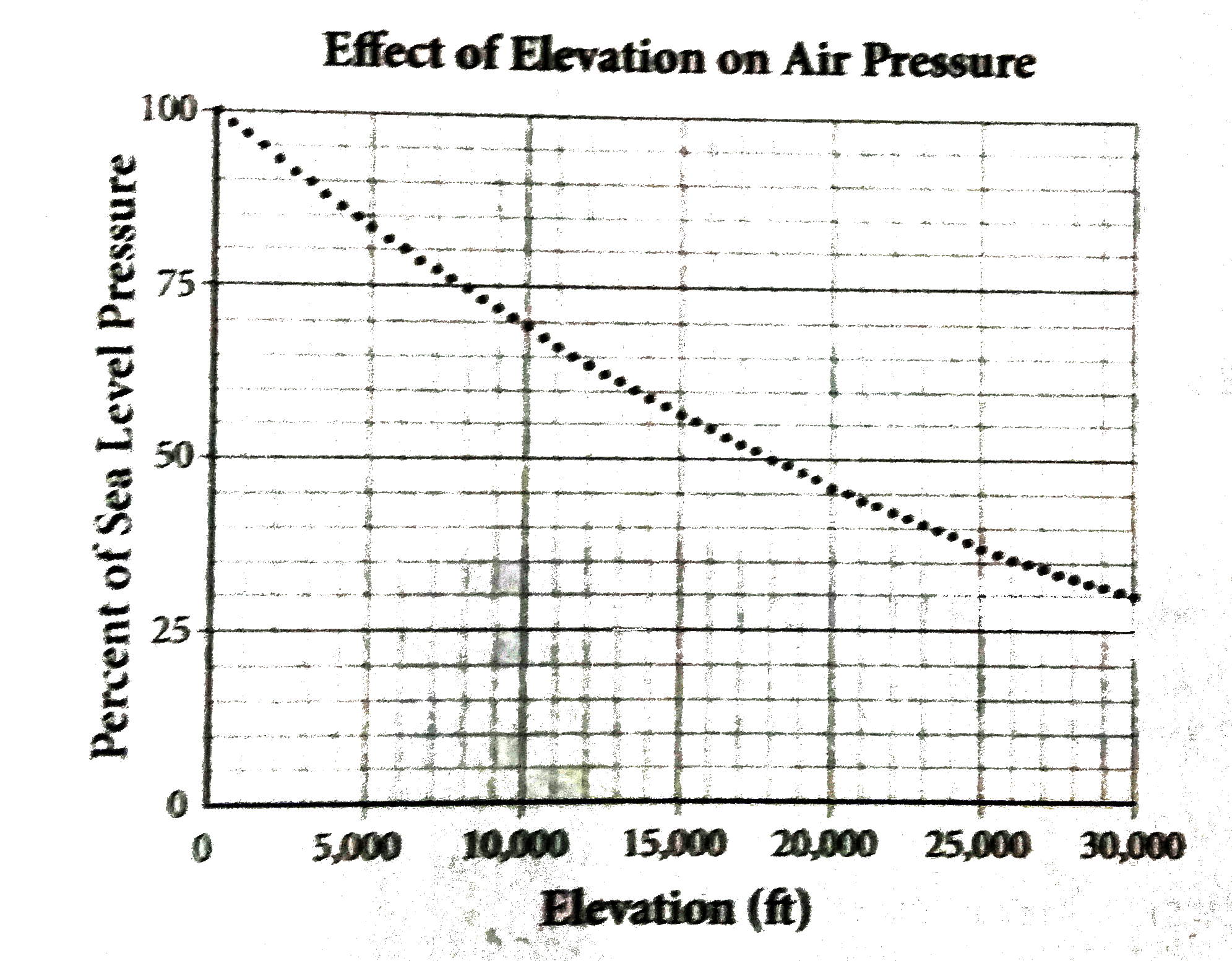At sea level, the composition of dry air is approximately N2=75.5%, O2=23.2%, and Ar=1.3% by mass. If the total pressure at sea level is 1bar, what is the partial pressure of each component?
To find the partial pressure of each component of dry air at sea level, we can follow these steps:
Step 1: Assume the Mass of Dry Air
Let's assume the mass of dry air is 100 grams. This simplifies our calculations since we can directly use the percentages by mass to find the mass of each component.
- Mass of Nitrogen (N₂) = 75.5 grams
- Mass of Oxygen (O₂) = 23.2 grams
- Mass of Argon (Ar) = 1.3 grams
Step 2: Calculate the Number of Moles of Each Component
To find the number of moles, we will use the formula:
Number of moles=MassMolar mass
- Molar mass of N₂ = 28 g/mol
- Molar mass of O₂ = 32 g/mol
- Molar mass of Ar = 40 g/mol
Calculating the moles:
- Moles of N₂ = 75.5 g28 g/mol≈2.68 moles
- Moles of O₂ = 23.2 g32 g/mol≈0.73 moles
- Moles of Ar = 1.3 g40 g/mol≈0.0325 moles
Step 3: Calculate Total Moles
Now, we will sum the moles of each component to find the total moles of air:
Total moles=Moles of N₂+Moles of O₂+Moles of Ar
Total moles=2.68+0.73+0.0325≈3.44 moles
Step 4: Calculate the Partial Pressure of Each Component
Using Dalton's Law of Partial Pressures, the partial pressure of each gas can be calculated using the formula:
Partial Pressure=(Moles of componentTotal moles)×Total Pressure
Given that the total pressure at sea level is 1 bar, we can calculate:
1. Partial Pressure of N₂:
PN₂=(2.683.44)×1 bar≈0.78 bar
2. Partial Pressure of O₂:
PO₂=(0.733.44)×1 bar≈0.21 bar
3. Partial Pressure of Ar:
PAr=(0.03253.44)×1 bar≈0.0095 bar
Final Results
- Partial Pressure of N₂: 0.78 bar
- Partial Pressure of O₂: 0.21 bar
- Partial Pressure of Ar: 0.0095 bar
Let's assume the mass of dry air is 100 grams. This simplifies our calculations since we can directly use the percentages by mass to find the mass of each component.
- Mass of Oxygen (O₂) = 23.2 grams
- Mass of Argon (Ar) = 1.3 grams
To find the number of moles, we will use the formula:
Number of moles=MassMolar mass
- Molar mass of O₂ = 32 g/mol
- Molar mass of Ar = 40 g/mol
- Moles of N₂ = 75.5 g28 g/mol≈2.68 moles
- Moles of O₂ = 23.2 g32 g/mol≈0.73 moles
- Moles of Ar = 1.3 g40 g/mol≈0.0325 moles
Now, we will sum the moles of each component to find the total moles of air:
Total moles=Moles of N₂+Moles of O₂+Moles of Ar
Total moles=2.68+0.73+0.0325≈3.44 moles
Using Dalton's Law of Partial Pressures, the partial pressure of each gas can be calculated using the formula:
Partial Pressure=(Moles of componentTotal moles)×Total Pressure
PN₂=(2.683.44)×1 bar≈0.78 bar
PO₂=(0.733.44)×1 bar≈0.21 bar
PAr=(0.03253.44)×1 bar≈0.0095 bar
- Partial Pressure of N₂: 0.78 bar
- Partial Pressure of O₂: 0.21 bar
- Partial Pressure of Ar: 0.0095 bar
Topper's Solved these Questions
- STATES OF MATTERBOOK - CENGAGE CHEMISTRY ENGLISHCHAPTER - STATES OF MATTEREXERCISE - Illustration
2 Videos
- STATES OF MATTERBOOK - CENGAGE CHEMISTRY ENGLISHCHAPTER - STATES OF MATTEREXERCISE - Exercises
21 Videos
- SOME BASIC CONCEPTS AND MOLE CONCEPTBOOK - CENGAGE CHEMISTRY ENGLISHCHAPTER - SOME BASIC CONCEPTS AND MOLE CONCEPTEXERCISE - Archives Subjective
11 Videos
- STOICHIOMETRYBOOK - CENGAGE CHEMISTRY ENGLISHCHAPTER - STOICHIOMETRYEXERCISE - Archives Subjective
33 Videos
Similar Questions
The masspercentage in composition of dry air at sea level contains contains approximately 75.5% of N2. If the total atmosphere pressure is 1 atm then what will be the partial pressure of nitrogen?
[Given : average molecular mass of air = 29]
View SolutionA cylinder contains 0.3 moles of N2, 0.1 mole of O2 and 0.1 mole of helium. If the total pressure is one atm, what is the partial pressure
of oxygen in mm Hg:-
View Solution
Knowledge Check
A gaseous mixture was prepared by taking equal moles of CO and N2. If the total pressure of the mixture was found 1 atmosphere, the partial pressure of the nitrogen (N2) in the mixture is
A0.8 atmB0.9 atmC1 atmD0.5 atm.
Air contains 79%N2 and 21%O2 by volume. If the barometric pressure is 750mmHg. The partial pressure of oxygen is
View SolutionA nitrogen-hydrogen mixture initially in the moler ratio of 1:3 reached equilibrium to from ammonia when 25% of the N2andN2 had reacterd .If the pressure of the system was 21 atm , the partial pressure of ammonia at the equilibrium was :
View SolutionA mixture of N2 and Ar gases in a cylinder contains 7g of N2 & 8 g of Ar. If the total pressure of the mixture of the gases in the cylinder is 27bar, the partial pressure of N2 is:
View SolutionAt STP, a container has 1 mole of Ar, 2 mole of CO2, 3 moles of O2 and 4 moles of N2. Without changing the total pressure if one mole of O2 is removed, the partial pressure of O2
View SolutionAs the elevation above sea level increase, the corresponding air pressure decrease. A scatterplot comparing elevations, in feet, to air pressure, as a percent of sea level pressure, is shown balow.

Q. Air pressure is sometimes measured in inches of mercury. If sea level air pressure measures as 29.2 inches of mercury, what is the approximate difference, in inches of mercury, between the pressure at sea level and the pressure at the death zone threshold?
View SolutionThe lowest concentration of oxygen that can support aquatic life is about 1.3×10−4mol/L . The partial pressure of oxygen is 0.21atm at sea level.
What is the lowest partial pressure of oxygen that can support life ?
kH(O2)=11.3×10−3mol/L.atm
View SolutionFind out partial pressure of O2 and CO2 in oxygenated blood.
View Solution
